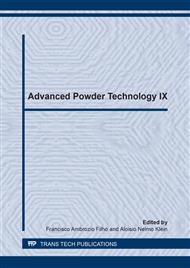p.472
p.477
p.483
p.491
p.496
p.501
p.507
p.512
p.518
Characterization of Porous Ti-35Nb Alloy Sintered at Different Temperatures for Implant Applications
Abstract:
Studies show that porous titanium alloys improve osseointegration at the implant-bone interface, since they induce new bone tissue formation inside the pores providing a better mechanical stability. In this work, porous Ti-35Nb samples were manufactured by powder metallurgy for orthopedic implant application. The titanium and niobium powders were mixing with a pore former additive and then uniaxially and cold-isostatically compacted. The samples sintering were performed at 1200oC and 1300oC. Samples characterization was performed by Scanning Electron Microscopy with Energy Dispersive X-Ray (SEM/EDS), X-Ray Diffractometry (XRD) and Optical Microscopy (OM). Moreover, ultrasound test and Quantitative Analysis by Optical Metallography (QAOM) were conducted to obtain the modulus of elasticity and total porosity, respectively. The results indicated that the used processing parameters made it possible to obtain homogeneous microstructures throughout the length of the sample.
Info:
Periodical:
Pages:
496-500
Citation:
Online since:
December 2014
Price:
Сopyright:
© 2014 Trans Tech Publications Ltd. All Rights Reserved
Share:
Citation:


